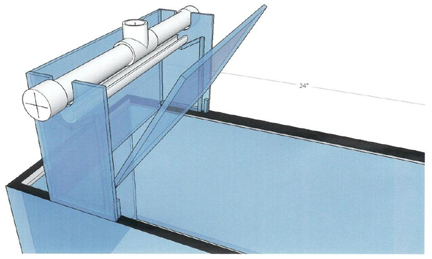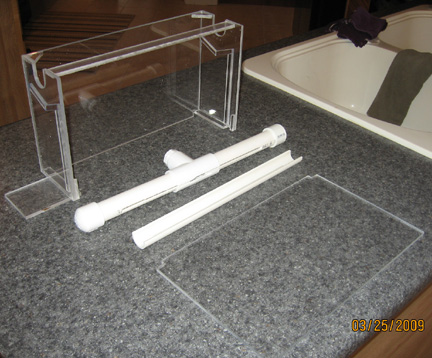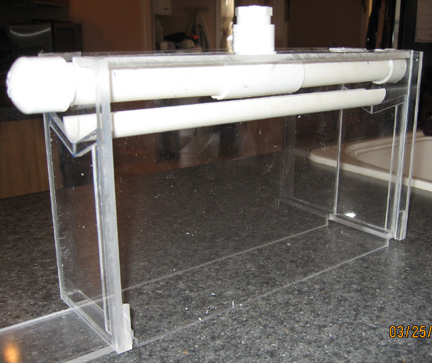Here are some of the most important parts of the Algae scrubber lsited from the FAQ on the website. Be sure to follow the exact guidelines or you will likley have issues. those who got inventive seemed to be the ones that didnt have that much success, those who kept to the guidlines seem to have nothing but praise for the systems....
Scrubber Quick Guideline:
0.5 actual (not equivalent) fluorescent watts per gallon MINIMUM [0.13 watts per liter].
1.0 actual (not equivalent) fluorescent watts per gallon for HIGH filtering [0.26 watts per liter].
1.0 square inches of screen per gallon, with bulbs on BOTH sides (10 x 10 = 100 square inches = 100 gal)
[1.64 square cm per liter]
2.0 square inches of screen per gallon, if vertical but lit on just ONE side. [3.28 square cm per liter]
4.0 square inches of screen per gallon, if HORIZONTAL [6.56 square cm per liter].
1.5 actual (not equivalent) fluorescent watts per gallon if HORIZONTAL [0.4 watts per liter].
18 hours of lights ON, and 6 hours of lights OFF, each day.
Flow is 24 hours, and is at least 35 gph per inch of width of screen, EVEN IF one sided [60 lph per cm].
Very rough screen made of roughed-up-like-a-cactus plastic canvas.
Clean algae off of screen every SEVEN (7) days NO MATTER WHAT YOU THINK.
Q: How big of a scrubber do I need?
A: Start with one square inch (6.25 square cm) of screen, with a light on both sides, for every U.S. gallon (3.8 liters) of water in your display tank. Thus, a 100 gallon display tank would need a screen 10 inches by 10 inches (100 square inches), with a light on both sides. If you can only put a light on one side, then you need to double the screen area, and also double the lighting on the one side. You don't need to include the volume of the sump, unless it also has livestock in it that you feed.
: What's the most important thing that I need to pay attention to when building my scrubber?
A: The screen. It needs to be ROUGH.
Q: Do I need to "seed" my screen with algae to get it to grow?
A: No. All screens will grow by themselves. Seeding (rubbing algae into the screen to get it started faster) is no longer recommended because is just does not speed things up enough, and it just puts extra waste into the water. If you want your screen to grow faster, then make it rougher by scraping a hole-saw (not in a drill) across the plastic canvas. The screen should feel like a cactus, and be too rough to rub on your face. The rougher it is, the faster algae will grow on it, and the longer the algae will stick to it.
Q: How do you clean a scrubber screen?
A: You clean it every 7 days, by removing the screen from the scrubber, taking it to your sink, and running tap water over it while removing the algae. Don't remove all the algae, however, because you want it to grow back quickly, and also because you need some algae to continue to do the filtering. So leave a small layer of algae on the screen. The rougher your screen is, the more algae will remain, and thus the faster the filtering will start again. If you have two separate screens, then you can clean one completely down to the plastic, since the other one continues the filtering. Also, if your screen is two layers (like a sandwich), you can also clean down to the plastic, since algae will remain between the two layers.
Q: How often do you clean it?
A: Once a week (7 days), NO MATTER WHAT. This is probably the biggest hassle with scrubbers, and when it is not followed, it's THE biggest reason why a scrubber is not working as good as it should. When the algae gets too thick on the screen, it blocks the light from getting to the bottom layers. Thus the bottom layers die, and they put nitrate and phosphate and cloudiness into the water. Weekly cleaning eliminates this. If your screen is smaller than it should be, or if your nutrients are very high in your tank, your screen might fill up and need cleaning in just a few days. This is ESPECIALLY true if the screen is growing dark, oil-like algae. This type of algae will never get thick because it blocks out all the light, so it must be cleaned as soon as it grows. After the nutrients in your water come down, the dark algae will grow less, and the green algae will grow more (dark algae is caused by very high nutrients.)
Q: What is the best type of scrubber to build?
A: For most new aquarists, simple and cheap scrubbers are best. Simple configurations are just a screen hanging in a sump. For intermediate aquarists, compact size and better performance might be wanted. These configurations might be custom built acrylic units, with very bright lighting. For advanced aquarists, compactness is usually not a concern, but strong performance, and redundancy of lighting and flow, is. So a dual or triple screen, dual-pump, multiple-light configuration would be best.
Q: Is a vertical or horizontal screen better?
A: Vertical is better. It is proven, and it is the smallest and most powerful for a given amount of space, flow, and lighting. Horizontal is OK if you want to experiment, but if you absolutely must have results, go vertical. The biggest operational problem with horizontal is that as algae builds up on the screen, it blocks flow to areas downstream from it. This is because the water is not flowing very fast, and it cannot "jump" up and over the new growth. So the more algae, the more blockage, and thus it is self-limiting unless you have a LOT of flow. With a vertical, however, the flow is rapid and goes right over new growth. This is the reason that a horizontal needs 4X the screen area, so it can make up for less performance.
Q: What kind of light do I need?
A: Experience has shown that at least a 23 Watt Compact Fluorescent (CFL) bulb, of the 2700K or 3000K (“warm” or “soft”) color, works best. One on each side of the screen, about 4" from the screen, and pointed to the middle of the screen. And note that 23W is "at least", unless it's for a nano. These CFL lights have also shown to only last about three months before their power drops off, even though they "look" fine. T5HO bulbs have also shown tremendous scrubber growth, although they are more difficult to design and build; their spread of light from side to side is superior to CFL bulbs. There is an upper limit to CFL bulb size; CFL bulbs in the 45 watt range are at the top, whereas anything higher than that will tend to “cook” the screen in one spot. If you must have more than 45 watts per side, use two smaller bulbs instead. The lighting just needs to be spread out more evenly, and not so concentrated in one spot. If you use CFL bulbs and they are not floodlights (which have built-in reflectors), be sure to get "CFL reflectors" so you can reflect the light to the screen.
Q: What if I can't fit a light on both sides of the screen?
A: Then double the screen size, and double the lights on the one side. Doubling the screen size without doubling the lighting, however, does no good.
Q: I can’t find the “K” numbers on the bulbs I want to buy; Can I use "soft" or "warm" bulbs?
A: Yes, the “soft or “warm” bulbs, which are the most popular types for the typical home, are about 2700 or 3000K and they work the best. Even “full spectrum” or “daylight” bulbs are OK. The ones which don’t work the best are “cool” bulbs. But they still work.
Q: How long do I wait before replacing the bulbs?
A: CFL bulbs should be replaced every 3 months. T5HO/PC bulbs every 3 to 6 months. Do NOT wait longer just because "they still look fine". You'll see, after you replace them, how dim they really were compared to the new ones. Leaving old bulbs in a scrubber can completely stop it from working.
Q: How near do the lights need to be to the screen?
A: CFL bulbs should be within 4 inches (10cm) from the middle of the screen. If you cannot get the light nearer than 6 inches (15cm), then do some reconfiguration. Don't build a scrubber at all if you can't get the light to within 6 inches (15cm). T5HO bulbs can be within 1 inch (2.5 cm) of the screen, but 2 inches is OK. Algae needs LIGHT POWER to grow.
Q: What's the best wattage/power bulb to use?
A: Generally, up to 45 watt CFL bulbs. The more powerful the light, the faster your nitrate, phosphate, and nuisance algae will be reduced, and the lower they will stay. The bare minimum for any setup is a 23W CFL Floodlight, 2700K or 3000K. A maximum might be a 45 watt bulb, but it’s better to have multiple smaller bulbs in order to reach your recommended total wattage. The ultimate are T5HO bulbs, which spread the light out so that the most light-power can be placed near the algae, without "burning" it in one spot like a CFL.
Q: I have some extra lights that I was using for my display; can I use those?
A: Only if they are 6500K or less. 10K is problematic. 14K and 20K will not work at all. And the power on each bulb still needs to be at least 23W, on each side of the screen.
Q: What's the best bulb color/spectrum?
A: The best would seem to be the "plant grow" spectrum. These bulbs looks "pink", and don't seem bright at all. But 2700K and 3000K seem to grow even better. No special testing has been done for this, however.
Q: How long should I leave the lights on?
A: 18 hours. Never run the lights 24/7, because the algae will "burn" and stop growing near the light. Algae needs rest. Amazingly, algae does most of it’s filtering in the dark; it just grows bigger in the light.
Q: How much flow do I need on the screen?
A: At least 35 U.S. gallons per hour (gph) (133 lph) for every inch (2.5cm) of width of the screen. Thus a screen one inch wide would need at least 35 gph, and a screen two inches wide would need at least 70 gph, etc. More is even better. Less flow means less performance, and parts of the screen may go dry. And if you are making a horizontal screen, you then want ALL the flow on the one (top) side. This is because fast flow is critical, and horizontal screens do not have fast flow. So you make up for this by putting all the flow from a two-sided screen onto the one top side of a one-sided screen. And in all screens, flow will be limited by the roughness of the screen, because a smooth screen will let go of algae sooner than a rough screen will.
Scrubber Materials:
Q: What's the best material to make the screen out of?
A: The overall best material is "plastic canvas", which can be found at any craft/sewing store, and online at hundreds of places. It's cheap, strong, and does not wear out. However it's smooth and it's made out of non-stick plastic, so to make it work the best, you need to rough it up using a hole-saw in your hand (not in a drill) so that it feels like a cactus. The rougher it is, the quicker the algae will grow, and the thicker it will grow without falling off, and thus the less nitrate, phosphate, and nuisance algae you will have in your display. Just remember that the more algae that can grow/stick on the screen, the less algae you will have in your tank.





